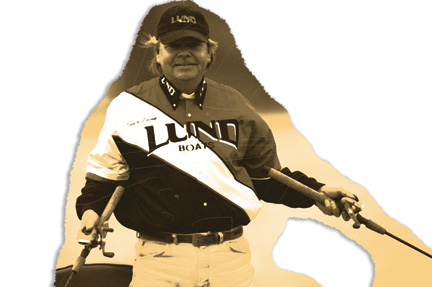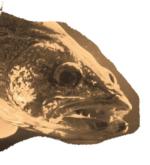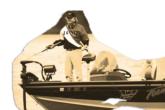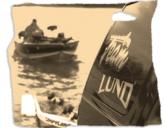Dixie walleyes
Try fishing for walleyes this year – south of the Mason-Dixon Line!

Walleyes aren’t just for Yankees anymore. Once popular only in the northern parts of our nation, they are rapidly gaining in popularity throughout the South.
Actually, walleyes have been a long-held secret in the South – anglers from Kentucky to Arkansas have been catching them for decades. It is the rest of the nation that is just beginning to catch on.
While Southern waters may not support the high numbers of walleyes that are found in the North, they do support big fish. Successful Wal-Mart RCL Walleye Tour competitors such as Steve Lamb of Nashville, Tenn., point out that Southern ‘eyes have the benefit of a long growing season and, as a result, reach huge proportions.
In fact, the somewhat infamous world-record walleye, a 25-pound behemoth, came from Lamb’s home state out of a lake not far from his home – Old Hickory.
Like most fish in the South, walleyes tend to spawn early. In most locales, February and March are the prime months, with many fish spawning as early as late January after a short or especially mild winter. Therefore, anglers wanting to get in on the action need to start their season early.
Tennessee angler and Southern-river walleye expert Earl Davis has decades of experience chasing walleyes in the Cumberland River. His favorite stretch is along the Tennessee and Kentucky state borders. He seeks areas of gravel, sand and chunk rock for his early-season angling.
Davis’ favorite technique is to troll a buoyant, hard-bodied, 3-inch crankbait in 6 to 8 feet of water. His preference is to run the lure just deep enough to tick the bottom from time to time. He believes this triggers a feeding response in the fish.
His favorite color choice is red, although upon rare occasions he will fish with a natural shad color, and he trolls with a medium-weight rod and spinning reel spooled with high-quality, abrasion-resistant, 12-pound-test line. He ties his line directly to the lure, and if necessary, he will place a swivel in the line to avoid twist.
If the fish are slow to accept his crankbait, he will often switch to a jig. His technique is at once simple and effective – a plain jighead with a minnow impaled on the hook. Every now and then he will switch to a hair jig if the water is clear and the fish are finicky. Interestingly, he has no preference when it comes to jig color. “Doesn’t seem to matter,” he says.
 Pete Gleason, another Southerner with serious walleye experience, regularly fishes Bull Shoals in Arkansas. His water, however, is much different than Davis’, and so is his approach.
Pete Gleason, another Southerner with serious walleye experience, regularly fishes Bull Shoals in Arkansas. His water, however, is much different than Davis’, and so is his approach.
Gleason, who has a 19 pound, 13-ouce trophy to his credit, reports that a number of huge, early-season walleyes are caught each year on big, hard-bodied jerkbaits. He recommends fishing the deep-diving models in bright orange colors. According to Gleason, these baits should be fished as slowly as possible – just fast enough to allow them to roll from side to side.
His favorite technique, however, is casting a big, shad-colored tube bait in a very unusual manner. He never allows it to touch the bottom. Gleason jerks the bait in a very erratic and haphazard manner, never repeating the same movement twice. This technique requires some practice but is well worth the effort.
His favorite location for early-season walleyes is the upper end of the lake, where there is one riffle after another with pools of deep water between them. The substrate in these areas is gravel, sand and chunk rock. He works the pools in a slow and methodical fashion, and his better catches have come from just below the riffles.
Jerkbaits will work in shallow areas, but the big tube is necessary to tempt deep-water ‘eyes. Gleason recommends fishing water between 8 and 20 feet deep until the magic depth is found.
Walleyes are subject to move at Bull Shoals, and the bite will turn on and off for unexplained reasons. Because of that, Gleason points out that there are no shortcuts. You must look for these fish every day and sometimes several times during each day.
He also recommends that anglers looking for quality catches consider beaching their boat and working from the shoreline. “There is less to go wrong from shore, and it is much more relaxing,” Gleason said.
At night, Gleason suggests fishing “shallow enough that they can almost get their dorsal fin out of the water.” His favored lures after dark include long, hard jerkbaits.
For those who prefer live bait, Gleason opines that it is hard to beat a minnow, hooked through the lips, on a simple bait hook. A little weight on the line and you are good to go. Just toss the rig out and let it drop to the bottom. From there, let it tumble around until you feel a little weight or resistance, and then set the hook.
Talk to professional walleye guide Barry Hardin or successful RCL Tour competitor Rick Franklin of Louisburg, Kan., about Greers Ferry, Ark., walleyes, and you get yet another perspective.
Hardin is a firm believer in long-line trolling with big, deep-diving crankbaits in rainbow-trout colors. He starts trolling with 150 feet of line out and works longer or shorter as the fish require. If the bite is slow he will, upon occasion, change to a shad color.
For his live-bait work, Hardin uses a crawler harness baited with a night crawler and weighted with a 2-ounce sinker.
 He trolls either the crankbait or live bait along main-lake points and flats until he finds the magic depth and speed. According to Hardin, a depth of 20 feet is a good place to start early in the year.
He trolls either the crankbait or live bait along main-lake points and flats until he finds the magic depth and speed. According to Hardin, a depth of 20 feet is a good place to start early in the year.
On the other hand, Franklin’s 10 years of guiding experience on the lake leads him to fish at anchor with bluegill (which are legal bait in Arkansas) in the upper end of the lake where the rivers flow into it. He says that this is one of the best early-season techniques for walleyes. Like the other anglers, he searches out areas of gravel, sand and chunk rock.
He also recommends fishing for pre spawn walleyes along the old river channels in the main lake after dark. Franklin searches for lights – any type of light, from street lights to dock lights. Once the lights are found, he fishes under them, as the lights attract baitfish, which in turn attract walleyes. This pattern will hold from December through the spawn.
During the spawn, Franklin says anglers should throw floating jerkbaits in shallow water after dark. When he says “shallow,” he means it; in some areas, less than a foot of water will produce.
Top 10
Greers Ferry (Arkansas):
Home of the 22-pound, 11-ounce monster that some organizations recognizes as the true world-record walleye, Greers Ferry has to be considered one of the top Southern spots in the nation. The deep, clear waters of this impoundment consistently produce trophy walleyes. The lake is now being managed for trophies with a slot limit. For complete information, contact Barry Hardin at (501) 825-8466.
Cumberland River (Tennessee/Kentucky):
The stretch of the Cumberland River from the bridge on Route 52 in Celina, Tenn., to McFarland Creek in southern Kentucky may be the best river destination in the South. River conditions can change quickly on the Cumberland, so check before departing for your trip. For complete information, contact Stephen Headrick at (931) 243-2636.
 Bull Shoals (Arkansas):
Bull Shoals (Arkansas):
This vast, sprawling Southern impoundment consistently produces trophy-size walleyes for those anglers willing to spend some time searching for them. A quality map is not an option on this body of water; it is a necessity. For complete information, contact Pete Gleason at (417) 546-6718.
Table Rock (Missouri):
Table Rock has a fine, if little-known, population of huge walleyes. This is a big body of water, so preparation is the key. Guides can be of some help, but you must do your homework if you expect to be successful on this legendary lake. For complete information, contact Jim Van Hook at (800) 603-4665.
Cumberland Lake (Kentucky):
Cumberland Lake has produced the Kentucky state record – a brute weighing more than 21 pounds. The rocky shorelines, long points and deep water make this a natural home for big walleyes. The walleye bite on Cumberland can be inconsistent, but the results can be extraordinary. For complete information, contact Randall Gibson at (270) 433-6333.
Dale Hollow (Tennessee):
The deep, crystal-clear waters of this reservoir can produce extraordinary catches of walleyes for those anglers who can decipher her secrets. Most of the quality catches from the ‘Hollow after early spring are at night. For complete information, contact Stephen Headrick at (931) 243-2636.
Smithville Lake (Missouri):
This lake is small (just over 7,000 acres) and relatively new (formed in 1979), but it is providing fine walleye fishing for Southern anglers. The average fish is smaller than at some of the other choices, but nevertheless, there have been several fish well over 20 inches taken recently. Smithville’s small size makes it less intimidating to some anglers. For complete information, contact Gary Burton at (816) 532-4659.
Smithland Pool, Ohio River (Kentucky):
The Smithland Pool at the lower end of the Ohio River produces fine catches of walleyes. This venue is unique in that it produces both numbers and size throughout the winter. The habitat in this area is varied; it ranges from classic river conditions to tailrace waters below the dams on to areas nicknamed “the bayous.” For complete information, contact Mike Wells at (800) 866-3636.
Green River Lake (Kentucky):
This small body of water is legendary among local anglers for high numbers of walleyes as well as a consistent bite. Once you develop a pattern on Green River Lake, it will usually hold for a long time. For complete information, contact Bobby Gentry at (270) 427-0419.
Saline River (Arkansas):
Some anglers would describe the Saline as closer to a creek than a river, but it produces fine numbers of walleyes. It runs through pristine and rugged wilderness and makes for a very different experience from the other selections. Leave big boats at home when you fish the Saline. Conditions can change quickly, so call for current information before departing on your trip. For complete information, contact the Arkansas Game and Fish Commission at (877) 525-8606.